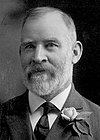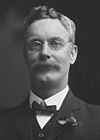
The Nationalist Party, also known as the National Party, was an Australian political party. It was formed in February 1917 from a merger between the Liberal Party and the National Labor Party, the latter formed by Prime Minister Billy Hughes and his supporters after the 1916 Labor Party split over World War I conscription. The Nationalist Party was established as a 'united' non-Labor opposition that had remained a political trend once the Labor party established itself in federal politics. The party was in government until electoral defeat in 1929. From that time it was the main opposition to the Labor Party until it merged with pro-Joseph Lyons Labor defectors to form the United Australia Party (UAP) in 1931. The party is a direct ancestor of the Liberal Party of Australia, the main centre-right party in Australia.

Andrew Fisher was an Australian politician and trade unionist who served as the fifth prime minister of Australia from 1908 to 1909, 1910 to 1913 and 1914 to 1915. He held office as the leader of the Australian Labor Party (ALP), and was particularly notable for leading the party to its first federal election victory and first majority government at the 1910 federal election.
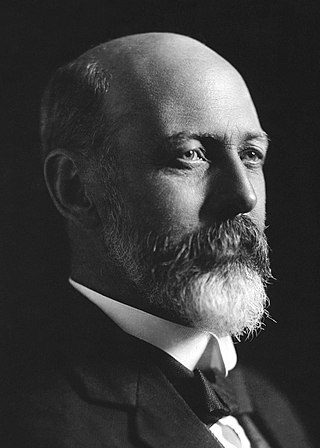
Sir Joseph Cook was an Australian politician and trade unionist who served as the sixth prime minister of Australia from 1913 to 1914. He held office as the leader of the Liberal Party, having previously been leader of the Anti-Socialist Party from 1908 to 1909. His victory at the 1913 election marked the first time that a centre-right party had won a majority at an Australian federal election.

Francis Gwynne Tudor was an Australian politician who served as the leader of the Australian Labor Party from 1916 until his death. He had previously been a government minister under Andrew Fisher and Billy Hughes.
The Liberal Party was a parliamentary party in Australian federal politics between 1909 and 1917. The party was founded under Alfred Deakin's leadership as a merger of the Protectionist Party and Anti-Socialist Party, an event known as the Fusion.

William Guthrie Spence, was an Australian trade union leader and politician, played a leading role in the formation of both Australia's largest union, the Australian Workers' Union, and the Australian Labor Party.

The Watson ministry (Labour) was the 3rd ministry of the Government of Australia, and the first national Labour government formed in the world. It was led by the country's 3rd Prime Minister, Chris Watson. The Watson ministry succeeded the First Deakin ministry, which dissolved on 27 April 1904 after Labour withdrew their support and Alfred Deakin was forced to resign. The ministry was replaced by the Reid ministry on 17 August 1904 after the Protectionist Party withdrew their support over the Conciliation and Arbitration Bill.

The Third Deakin ministry (Liberal) was the 7th ministry of the Government of Australia. It was led by the country's 2nd Prime Minister, Alfred Deakin. The Fourth Deakin ministry succeeded the First Fisher ministry, which dissolved on 2 June 1909 after the Protectionist Party and the Anti-Socialist Party merged into the Liberal Party "fusion" and withdrew their support in order to form what became the first majority government in federal Australian history. The ministry was replaced by the Second Fisher ministry on 29 April 1910 following the federal election that took place on 13 April which saw the Labour Party defeat the Liberals.

The First Fisher ministry (Labour) was the 6th ministry of the Government of Australia. It was led by the country's 5th Prime Minister, Andrew Fisher. The First Fisher ministry succeeded the Second Deakin ministry, which dissolved on 13 November 1908 after Labour withdrew their support and Alfred Deakin was forced to resign. The ministry was replaced by the Third Deakin ministry on 2 June 1909 after the Protectionist Party and the Anti-Socialist Party merged into the Liberal Party "fusion" and withdrew their support in order to form what became the first majority government in federal Australian history.
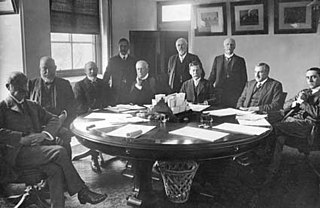
The Cook ministry (Liberal) was the 9th ministry of the Government of Australia. It was led by the country's 6th Prime Minister, Joseph Cook. The Cook Ministry succeeded the Second Fisher ministry, which dissolved on 24 June 1913 following the federal election that took place in May which saw the Liberals defeat Andrew Fisher's Labor Party - albeit with a one-seat majority. The ministry was replaced by the Third Fisher ministry on 17 September 1914 following the federal election that took place on 5 September which saw Labor defeat the Liberals.

The Third Fisher ministry (Labor) was the 10th ministry of the Government of Australia. It was led by the country's 5th Prime Minister, Andrew Fisher. The Third Fisher ministry succeeded the Cook ministry, which dissolved on 17 September 1914 following the federal election that took place on 5 September which saw Labor defeat Joseph Cook's Liberals. The ministry was replaced by the First Hughes ministry on 27 October 1915 following Fisher's retirement from Parliament to become the next High Commissioner to the United Kingdom.
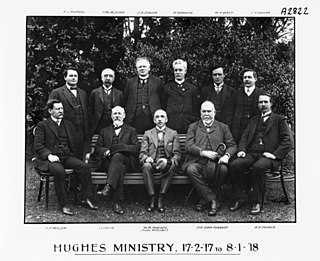
The Third Hughes ministry (Nationalist) was the 13th ministry of the Government of Australia. It was led by the country's 7th Prime Minister, Billy Hughes. The Third Hughes ministry succeeded the Second Hughes ministry, which dissolved on 17 February 1917 after the governing National Labor Party merged with the Liberal Party to form the Nationalist Party. The National Labor Party itself formed as a consequence of the split that took place within the then-governing Labor Party over the issue of conscription. The ministry was replaced by the Fourth Hughes ministry on 8 January 1918 following the resignation of Hughes as prime minister after a vote of no-confidence within the Nationalist Party in the wake of a failed second referendum on conscription. However, due to a lack of alternative leaders, Hughes was immediately re-commissioned as prime minister by Governor-General Sir Ronald Munro Ferguson.

The First Bruce ministry was the 16th ministry of the Government of Australia. It was led by the country's 8th prime minister, Stanley Bruce. The First Bruce ministry succeeded the Fifth Hughes ministry, which dissolved on 9 February 1923 following the December 1922 federal election and the subsequent resignation of Billy Hughes as prime minister. The Nationalists had lost their majority in the election, and had no choice but to negotiate a Coalition deal with the Country Party. However, Country leader Earle Page let it be known that no deal could be made unless Hughes resigned. It is the first ministry that consists of a centre-right Coalition between the senior conservative party and the junior rural party - this Coalition has more or less endured to this day with the modern-day Liberal Party and National Party. The ministry was replaced by the Second Bruce ministry on 18 December 1925 following the 1925 federal election.
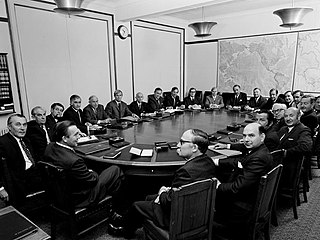
The McMahon ministry was the 46th ministry of the Australian Government. It was led by the country's 20th Prime Minister, William McMahon. The McMahon ministry succeeded the Second Gorton ministry, which dissolved on 10 March 1971 following the resignation of John Gorton as Prime Minister. The ministry was replaced by the First Whitlam ministry on 5 December 1972 following the federal election that took place on 2 December which saw Labor defeat the Coalition.
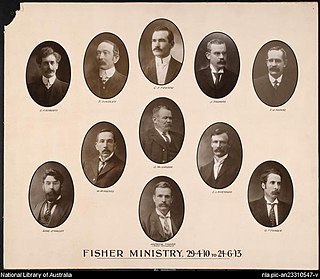
The Second Fisher ministry was the 8th ministry of the Government of Australia. It was led by the country's 5th Prime Minister, Andrew Fisher. The Second Fisher ministry succeeded the Third Deakin ministry, which dissolved on 29 April 1910 following the federal election that took place on 13 April which saw Labor defeat the Alfred Deakin's Liberal Party. It is the first federal government in Australian history to be elected with a majority in the House of Representatives, as well as the first majority national Labor government in the world. The ministry was replaced by the Cook ministry on 24 June 1913 following the federal election that took place in May which saw the Liberals defeat Labor.
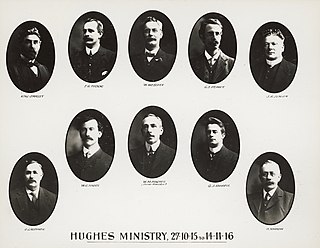
The First Hughes ministry (Labor) was the 11th ministry of the Government of Australia. It was led by the country's 7th Prime Minister, Billy Hughes. The First Hughes ministry succeeded the Third Fisher ministry, which dissolved on 27 October 1915 following Andrew Fisher's retirement from Parliament to become the next High Commissioner to the United Kingdom. The ministry was replaced by the Second Hughes ministry on 14 November 1916 following the split that took place within Labor over the issue of conscription. This led to Hughes and his supporters leaving the party to form the National Labor Party.
The Electoral district of Brown Hill-Ivanhoe was a Legislative Assembly electorate in the state of Western Australia. It covered part of the Goldfields city of Boulder, near Kalgoorlie, and neighbouring mining areas. It was created at the 1911 redistribution out of the former seats of Brown Hill and Ivanhoe, and was first contested at the 1911 election. It was abolished in the 1948 redistribution, with its area split between the neighbouring electorates of Boulder and Hannans, taking effect from the 1950 election. The seat was a very safe one for the Labor Party.

The 1917 Australian federal election was held in Australia on 5 May 1917. All 75 seats in the House of Representatives and 18 of the 36 seats in the Senate were up for election. The incumbent Nationalist Party, led by Prime Minister Billy Hughes, defeated the opposition Labor Party led by Frank Tudor in a landslide.
This is a list of members of the Australian Senate from 1914 to 1917. The 5 September 1914 election was a double dissolution called by Prime Minister of Australia Joseph Cook in an attempt to gain control of the Senate. All 75 seats in the House of Representatives, and all 36 seats in the Senate were up for election. The incumbent Commonwealth Liberal Party was defeated by the opposition Australian Labor Party led by Andrew Fisher, who announced with the outbreak of World War I during the campaign that under a Labor government, Australia would "stand beside the mother country to help and defend her to the last man and the last shilling."
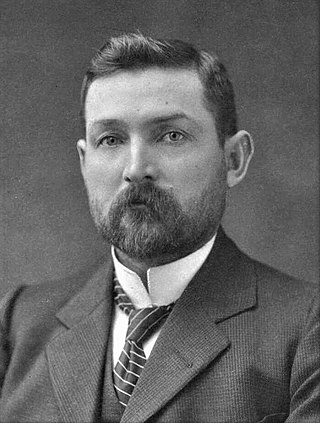
The Watson government was the third federal executive government of the Commonwealth of Australia. It was led by Prime Minister Chris Watson of the Australian Labor Party from 27 April 1904 to 18 August 1904. The Watson government was the first Labor Party national government in both Australia and in the world. Watson was aged just 37 when he became Prime Minister of Australia, and remains the youngest person to have held the post.



